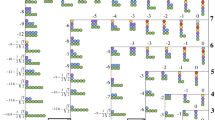Abstract
When gravitational aggregates are spun to fission they can undergo complex dynamical evolution, including escape and reconfiguration. Previous work has shown that a simple analysis of the full 2-body problem provides physically relevant insights for whether a fissioned system can lead to escape of the components and the creation of asteroid pairs. In this paper we extend the analysis to the full 3-body problem, utilizing recent advances in the understanding of fission mechanics of these systems. Specifically, we find that the full 3-body problem can eject a body with as much as 0.31 of the total system mass, significantly larger than the 0.17 mass limit previously calculated for the full 2-body problem. This paper derives rigorous limits on a fissioned 3-body system with regards to whether fissioned system components can physically escape from each other and what other stable relative equilibria they could settle in. We explore this question with a narrow focus on the Spherical Full Three Body Problem studied in detail earlier.










Similar content being viewed by others
References
Arnold, V.I., Kozlov, V.V., Neishtadt, A.I.: Encyclopaedia of Mathematical Sciences: Dynamical Systems III. Springer, Berlin (1988)
Boldrin, L.A.G., Scheeres, D.J., Winter, O.C.: Dynamics of rotationally fissioned asteroids: non planar case. Mon. Not. R. Astron. Soc. 461, (4), 3982–3992 (2016)
Cendra, H., Marsden, J.E.: Geometric mechanics and the dynamics of asteroid pairs. Dyn. Syst. Int. J. 20, 3–21 (2005)
Jacobson, S.A., Scheeres, D.J.: Dynamics of rotationally fissioned asteroids: source of observed small asteroid systems. Icarus 214, 161–178 (2011)
Maciejewski, A.J.: Reduction, relative equilibria and potential in the two rigid bodies problem. Celest. Mech. Dyn. Astron. 63(1), 1–28 (1995)
Polishook, D., Moskovitz, N., Binzel, R.P., DeMeo, F.E., Vokrouhlickỳ, D., Žižka, J., et al.: Observations of fresh and weathered surfaces on asteroid pairs and their implications on the rotational-fission mechanism. Icarus 233, 9–26 (2014)
Polishook, D., Moskovitz, N., DeMeo, F.E., Binzel, R.P.: Rotationally resolved spectroscopy of asteroid pairs: no spectral variation suggests fission is followed by settling of dust. Icarus 243, 222–235 (2014)
Pollard, H.: Celestial Mechanics. The Carus Mathematical Monographs. Mathematical Association of America, Providence (1976)
Pravec, P., Vokrouhlickỳ, D., Polishook, D., Scheeres, D.J., Harris, A.W., Galád, A., et al.: Formation of asteroid pairs by rotational fission. Nature 466(7310), 1085–1088 (2010)
Scheeres, D.J.: Stability in the full two-body problem. Celest. Mech. Dyn. Astron. 83(1), 155–169 (2002)
Scheeres, D.J.: Rotational fission of contact binary asteroids. Icarus 189(2), 370–385 (2007)
Scheeres, D.J.: Minimum energy asteroid reconfigurations and catastrophic disruptions. Planet. Space Sci. 57(2), 154–164 (2009)
Scheeres, D.J.: Stability of the planar full 2-body problem. Celest. Mech. Dyn. Astron. 104(1), 103–128 (2009)
Scheeres, D.J.: Minimum energy configurations in the \(N\)-body problem and the celestial mechanics of granular systems. Celest. Mech. Dyn. Astron. 113(3), 291–320 (2012)
Scheeres, D.J.: Hill stability in the full 3-body problem. Proc. Int. Astron. union 9(S310), 134–137 (2014)
Scheeres, D.J.: Hill stability of configurations in the full \(N\)-body problem. In: Proceedings of the international astronomical union (S318) (2015)
Scheeres, D.J.: Relative equilibria in the full \(N\)-body problem with applications to the equal mass problem. In: Bonnard, B., Chyba, M. (eds.) Recent Advances in Celestial and Space Mechanics, pp. 31–81. Springer (2016a)
Scheeres, D.J.: Relative equilibria in the spherical, finite density three-body problem. J. Nonlinear Sci. 26, 1445–1482 (2016b)
Scheeres, D.J., Britt, D., Carry, B., Holsapple, K.A.: Asteroid interiors and morphology. In: Michel, P., DeMeo, F., Bottke, W.M. Jr, (eds.) Asteroids IV. University of Arizona Press (2015)
Vokrouhlickỳ, D., Nesvornỳ, D.: Pairs of asteroids probably of a common origin. Astron. J. 136(1), 280 (2008)
Wang, L.S., Krishnaprasad, P.S., Maddocks, J.H.: Hamiltonian dynamics of a rigid body in a central gravitational field. Celest. Mech. Dyn. Astron. 50(4), 349–386 (1990)
Acknowledgements
The author acknowledges support from NASA Grant NNX14AL16G from the Near Earth Objects Observation programs.
Author information
Authors and Affiliations
Corresponding author
Rights and permissions
About this article
Cite this article
Scheeres, D.J. Constraints on bounded motion and mutual escape for the full 3-body problem. Celest Mech Dyn Astr 128, 131–148 (2017). https://doi.org/10.1007/s10569-016-9745-5
Received:
Revised:
Accepted:
Published:
Issue Date:
DOI: https://doi.org/10.1007/s10569-016-9745-5




